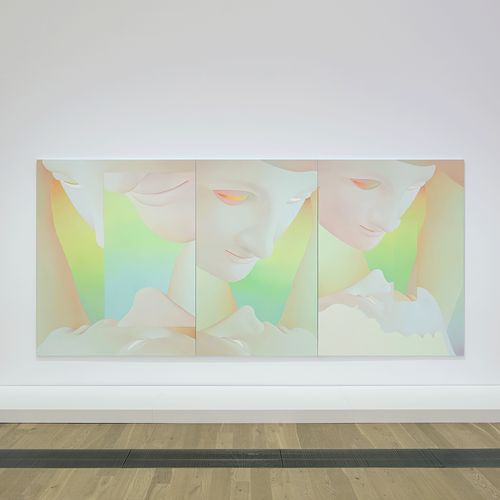AUDIO
Vivian Greven
Vivian Greven’s paintings confront us with new interpretations of art-historical subjects: she superimposes, mirrors, and fractures classical figures and myths, rendering them both alienated and surprisingly contemporary. Here we bring together three pieces, which await your discovery at various places throughout the exhibition.
In Psy Amo (7–9), Vivian Greven zooms in on a scene from Greek mythology. “Psy” stands for Psyche and “Amo” for Amor or Cupid. We see only the faces of Psyche and Cupid, repeated multiple times, but the decisive moment never comes: no kiss, no touch, just anticipation and suspense held in limbo. The focus on one moment in the story, and on the empty space between the figures, contrasts with the large size of the painting. The background shimmers through all the colors of the rainbow from red to violet. The artist layers, varies, repeats. The scene looks frozen in time.
Greven’s paintings play with our expectations. She zooms in, fragments, disrupts the surface. And sometimes something in the picture remains hidden.
In Venus I, an almost transparent cloth covers the body, a reference to Antonio Corradini’s famous sculpture Vestal Virgin Tuccia. Here, however, instead of eroticism, a critical examination of cultural ideals of beauty takes center stage. Painterly manipulations have “wounded” the transparent cloth that covers Venus’s torso—a deconstruction of classical Venus iconography. Greven transforms the goddess from an object of desire into an encrypted, unsettling surface.
In Theresa VII, the saint’s expression remains enigmatic—she appears rapturous, but without drama or divine ecstasy. We see only an open mouth that draws us deep into the picture and almost into Teresa’s body itself. Greven reduces the image and breaks with religious iconography. We cannot classify this ecstasy. Is it spiritual or physical? She leaves the question open …
Greven’s pictures depict not classic heroes, but fragility, superficiality, and doubt. They combine art-historical viewing habits with those of the present day.
And they ask: What remains of the myth in the digital age?
In Psy Amo (7–9), Vivian Greven zooms in on a scene from Greek mythology. “Psy” stands for Psyche and “Amo” for Amor or Cupid. We see only the faces of Psyche and Cupid, repeated multiple times, but the decisive moment never comes: no kiss, no touch, just anticipation and suspense held in limbo. The focus on one moment in the story, and on the empty space between the figures, contrasts with the large size of the painting. The background shimmers through all the colors of the rainbow from red to violet. The artist layers, varies, repeats. The scene looks frozen in time.
Greven’s paintings play with our expectations. She zooms in, fragments, disrupts the surface. And sometimes something in the picture remains hidden.
In Venus I, an almost transparent cloth covers the body, a reference to Antonio Corradini’s famous sculpture Vestal Virgin Tuccia. Here, however, instead of eroticism, a critical examination of cultural ideals of beauty takes center stage. Painterly manipulations have “wounded” the transparent cloth that covers Venus’s torso—a deconstruction of classical Venus iconography. Greven transforms the goddess from an object of desire into an encrypted, unsettling surface.
In Theresa VII, the saint’s expression remains enigmatic—she appears rapturous, but without drama or divine ecstasy. We see only an open mouth that draws us deep into the picture and almost into Teresa’s body itself. Greven reduces the image and breaks with religious iconography. We cannot classify this ecstasy. Is it spiritual or physical? She leaves the question open …
Greven’s pictures depict not classic heroes, but fragility, superficiality, and doubt. They combine art-historical viewing habits with those of the present day.
And they ask: What remains of the myth in the digital age?
